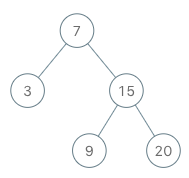Implement an iterator over a binary search tree (BST). Your iterator will be initialized with the root node of a BST.
Calling next() will return the next smallest number in the BST.
BSTIterator iterator = new BSTIterator(root); iterator.next(); // return 3 iterator.next(); // return 7 iterator.hasNext(); // return true iterator.next(); // return 9 iterator.hasNext(); // return true iterator.next(); // return 15 iterator.hasNext(); // return true iterator.next(); // return 20 iterator.hasNext(); // return false next()andhasNext()should run in average O(1) time and uses O(h) memory, where h is the height of the tree.- You may assume that
next()call will always be valid, that is, there will be at least a next smallest number in the BST whennext()is called.
# Definition for a binary tree node.# class TreeNode:# def __init__(self, val=0, left=None, right=None):# self.val = val# self.left = left# self.right = rightclassBSTIterator: def__init__(self, root: TreeNode): self.stack= [] self.curr=rootwhileself.curr: self.stack.append(self.curr) self.curr=self.curr.leftdefnext(self) ->int: """ @return the next smallest number """self.curr=self.stack.pop() ret=self.curr.valself.curr=self.curr.rightwhileself.curr: self.stack.append(self.curr) self.curr=self.curr.leftreturnretdefhasNext(self) ->bool: """ @return whether we have a next smallest number """returnself.stack# Your BSTIterator object will be instantiated and called as such:# obj = BSTIterator(root)# param_1 = obj.next()# param_2 = obj.hasNext()